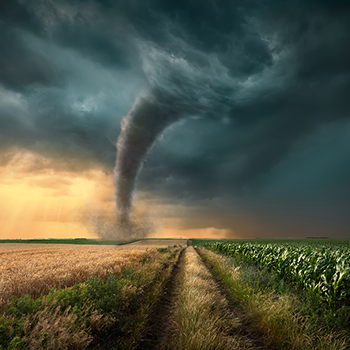Store Locator
Store Locator
The following information is provided by Nationwide®, an insurance and financial services company.

Almost 40 tornadoes hit the Midwest and Southeast in one day in December 2015, the largest such outbreak in observed U.S. weather history. A derecho with hurricane-strength winds traveled almost 800 miles through the Corn Belt in August 2020. Both caused massive, unexpected damage to life and property.
Such weather events range in type and severity depending on the region but are all fueled by changing global climate trends. They have one thing in common: They’re happening a lot more often. It’s a call to make sure you have the right emergency action plans and insurance policies in place to protect yourself, your family, and your farm or ranch.
Difference between weather and climate
Climate refers to the overall trends in specific weather that elapse over time, according to Justin Glisan, Iowa State Climatologist with the Iowa Department of Agriculture and Land Stewardship. On November 9, 2022, he led a webinar sponsored by Nationwide on current weather and climate trends as they relate to agriculture.
“Weather is the short-term variation in the atmosphere like wind, temperature, and precipitation,” he said. “Climate accounts for long-term trends like the amount of water vapor that can be held in the atmosphere and how that affects weather.”
Layer on things like increasing observed carbon dioxide levels in the atmosphere, and variables like atmospheric water vapor levels contribute to the rising frequency of severe events like heavy rains that can damage agricultural land through flooding and soil erosion.
“With rising water vapor in the atmosphere, we've seen an increase in the number of higher-intensity rain events across the Midwest,” Glisan said.
Meanwhile, 1,700 miles to the west, global climate trends favor the opposite outcome where Dr. Amrith Gunasekara lives and works. The Director of Science and Research for California Farm Bureau® said his region is much more likely to experience drought and resulting crop failures, grass fires, and wildfires.
“We broke some records with drought in 2022, and there are more to come,” Dr. Gunasekara said during the November webinar. “Wildfires are related to climate change and the weather variables of drought, precipitation, and increased temperatures.”
How does volatile weather and climate change affect agriculture?
For one, they create a range of risks. Smoke from California wildfires, for example, adversely affects output and quality for crops like grapes, and it eventually makes its way to the Midwest and alters the photosynthetic activity of corn and soybeans. Rising nighttime temperatures and humidity fuel thunderstorms and affect crop growth and the health of livestock and the people who tend to it. And crop insect and disease pressures are changing.
Make sure you’re protected
Farmers and ranchers should always be aware of the severe weather events their operations are likely to face. Interest in “smart” agriculture in the western U.S. is rising as growers turn to technology to sustain ag output. A sound strategy also includes planning for severe weather events and making sure you have the right risk protection in place.
Talk to your local Nationwide Farm agent to make sure you have the insurance coverages you need. And visit AgInsightCenter.com for more resources and expert tips on trending topics to help you run a successful business and maintain the safety of your operation.
Nationwide, the Nationwide N and Eagle, and Nationwide is on your side are service marks of Nationwide Mutual Insurance Company. © 2023 Nationwide